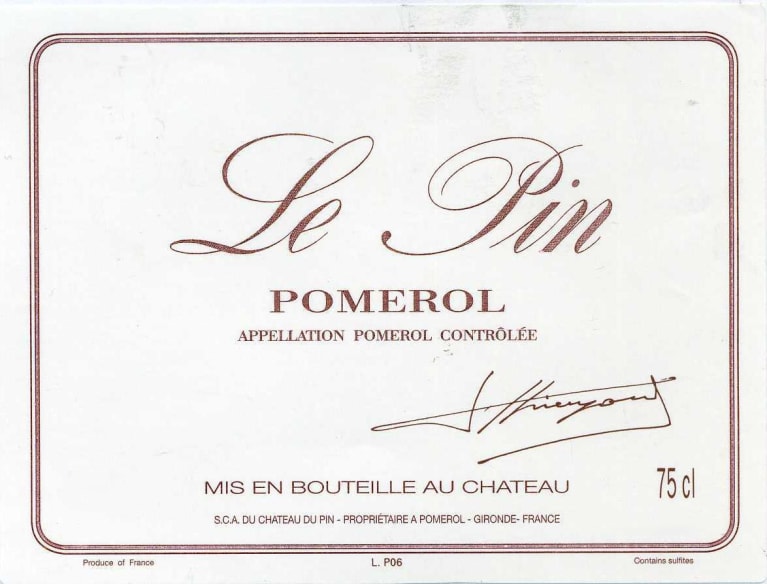Menu

By placing bids on items you acknowledge you are entering into a binding and irrevocable agreement to purchase such items as governed by our Terms and Conditions.

By placing bids on items you acknowledge you are entering into a binding and irrevocable agreement to purchase such items as governed by our Terms and Conditions.

Bordeaux
Free Valuations
Bid for Wine offer free no obligation wine valuations. If you have similar wines to sell, or want a valuation on a collection we can help.
Start Valuation
Le Pin is one of the most expensive wines in the world. All the more fascinating considering Le Pin made its debut with the 1979 vintage. Le Pin takes its name from the lone pine tree situated near the winery.
Since 1924 the land that is now known as Chateau Le Pin had been the property of the Loubie family. The grapes were sold or blended to produce other Pomerol wines until 1978. In 1979 it was thought that the vines of Chateau Le Pin would become part of Vieux Chateau Certan but the cost of the land stopped this happening. Subsequently Jacques Thienpont purchased the 2 hectare property for one million French Francs and Le Pin was born. He purchased a pretty ramshackle affair, the cellars Le Pin were in poor condition, the chai was a shed to store gardening tools and house on the property was dilapidated. Jacques Thienpont decided to add a single, 50 hectolitre stainless steel vat and the inaugural vintage of Le Pin was aged in used French oak barrels passed down from Vieux Chateau Certan.
The cellar was a simple, small, cool, cement room with the ability to hold only a few rows of barrels, this was however not a problem as the production was tiny. That first vintage of Le Pin sold for 100 French Francs per bottle, a lot lower than Vieux Chateau Certan was selling for, but buyers for the 1979 Le Pin were hard to find. The early vintages resulted in a miniscule amount of Le Pin being made was because close to half the vineyard had just been replanted, and the vines were too young to use.
In 1982, Le Pin consisted of a single hectare, next to a pine tree. Jacques Thienpont recognised the quality of the soil some years earlier. The original idea was to incorporate the parcel into Vieux Chateau Certan close by, but when that didn't work out, Jacques and his father and uncle contrived to buy the vineyard in 1979, with a small share being held by Alexandre Thienpont of Vieux Chateau Certan.
Today the total area under vine still stands at a modest 2.7ha. In 1984, Le Pin grew by .6 hectares, when Jacques Thienpont was able to buy land that was being used as, believe it or not, a vegetable garden! He obtained more land in 1985 and 1986 as well. Additional vines were purchased later in the first decade of the 21st century. This is when Le Pin acquired the famous 7 rows of vines that were located next to their vineyard. However, in 2012, they were not as lucky. A neighbouring Pomerol vineyard with a similar terroir came up for sale and it was quickly bought by Christian Moueix.
The famed wine critic Robert Parker is responsible for making the Pomerol wine of Le Pin famous, coveted and expensive. Prior to the 1982 vintage people outside of Pomerol had not heard of the wine and Robert Parker's initial review of Le Pin was lukewarm at best. By the time the 1982 Le Pin began maturing, Robert Parker had re-tasted the wine and his enthusiastic, descriptive, praise for the 1982 Le Pin vintage caused collectors to seek it out. With only a few hundred cases per year being made the price of Le Pin soared.
The miniscule 2.7 hectare vineyard of Le Pin is planted to almost 100% Merlot. The terroir of Le Pin is clay with gravel and sand with deposits of iron oxide in the soil. The gravel is deep. In some parts of the vineyard, the gravel is close to 3 metres thick and the vineyard is ideally placed with good elevation on the Pomerol plateau. Situated near the Catusseau village, the vines average close to 35 years of age although some older vines date back to the 1950's. The vineyard of Le Pin is planted to a vine density of 6,000 vines per hectare.
Le Pin was probably the first chateau in all of Bordeaux to conduct malolactic fermentation in barrel. Interestingly, this was by accident and not by design. In their formative years, they did not have enough tanks to hold all the wine for fermentation. So, out of necessity, following alcoholic fermentation, they moved the wine to barrel as an experiment for malolactic fermentation and it worked.
Le Pin currently produces between 400 and 600 cases per year. The wine of Le Pin is vinified in 7 small, stainless steel tanks that range in size from 15 hectolitres up to 42 hectolitres. In the cellars, all wine is moved by gravity. Malolactic fermentation takes place in new oak. The wine is aged in 100% new, French oak. Blending takes place prior to bottling and Jacques Thienpont is extremely conscious of quality when it comes to how much of the wine is released. During selection any lots not deemed worthy of Le Pin are declassified and in 2003 the entire vintage was declassified.
There is no second wine at Le Pin but they do produce a tiny amount of Trilogie, which is a multi-vintage blend of 3 different years, made from various declassified lots.